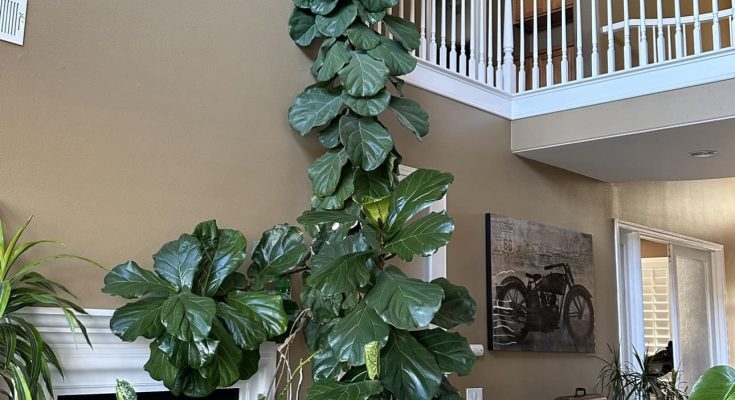While we often think of ivy thriving outdoors—climbing up a brick wall, spilling over a fence, or winding its way across the ground—it’s also a popular houseplant, and with the right care, it can grow well indoors. Most species of ivy are easy-care plantings, but there are some tricks to keep them growing at their best. They’re easy to propagate, and they don’t require much attention. In short, they make good houseplants. Foliage varies in shape and color, from dark green to silver to variegated. Plant indoors anytime. Some varieties grow very quickly at several feet per year.
Here’s how to successfully grow ivy plants indoors and some types to consider. Keep in mind that all parts of English ivy are toxic to people, dogs, cats, and horses.12
:max_bytes(150000):strip_icc():format(webp)/GettyImages-1283014018-2000-ff9e2ad7756f400c9ed8f22aca4e1220.jpg)
Indoor Ivy Plant Care
Ivy species are climbing vines and rambling ground covers, and they can both thrive in shade with moderate to regular water and tolerate some sun. Grown indoors, their growing conditions are much the same. They grow and spread quickly outdoors, and indoors that attractive growth spills and trails from containers and hanging baskets.
Light
When indoors, it’s good to give your ivy bright, indirect light. With too much shade, the plant can grow leggy, and too much direct light can scorch its leaves. Variegated varieties like less direct light and are a better choice for low-light areas.
Soil
Ivy grows best when planted in well-drained, loose soil that’s made for houseplants. Use a pot with lots of drainage holes.
Water
Most ivy varieties have moderate water requirements and don’t like to be soggy, so be sure to let the soil dry out between waterings. Once a week during the spring and summer, and less often in winter, is typical. While indoor ivy doesn’t like to be too moist, it appreciates an occasional spritz of water, especially when the air is dry.
Temperature and Humidity
Humidity is generally good for ivy, and moderate temperatures are ideal.3 Ivies need room temperatures around 50°F to 70°F during the day.
Fertilizer
Don’t fertilize too often; feeding ivy once a month during the warmer months is usually a good bet.3
:max_bytes(150000):strip_icc():format(webp)/GettyImages-134573942-2000-1ef9040fa3ec4c4eb23d9118af351010.jpg)
Types of Indoor Ivy Plants
There are many varieties of ivy that can be grown indoors. Here are some to look for:
- Algerian Ivy (Hedera canariensis): Grown as a houseplant, this ivy needs frequent trimming as it grows quickly. Leaves are glossy, and many varieties are variegated.
- Needlepoint English Ivy (Hedera helix ‘Needlepoint’): Dark green leaves have three to five lobes that are sharply pointed.
- Glacier English Ivy (Hedera helix ‘Glacier’): Deeply pointed gray-green leaves feature creamy white edges.
- Gold Dust English Ivy (Hedera helix ‘Gold Dust’): This gets its name from the mottled coloring that resembles gold flecks.
Pruning
When your ivy gets too long, you can clip off sections of the stem to keep it shaped and under control. Use clean scissors to snip long, leggy vines just above a leaf to encourage bushier growth.
Propagating Indoor Ivy Plants
To propagate more plants, you can take clippings and root them in water or soil to start new ivy plantings. Start with an English Ivy (like ‘Gold Dust’ or ‘Baltica’) or an Algerian Ivy for pretty deep green or variegated green-and-cream leaves. Here’s what to do:
- Use clean pruning shears to cut a 5-inch piece of ivy that has several leaf nodes.
- Remove the bottom leaves and place the cuttings directly in water or in moist soil.
- Place the cuttings in an area with bright, indirect light.
- When roots emerge, transplant the cutting to a pot.
If you like ivy but are worried about it taking off and taking over your yard, growing it indoors is a good way to keep it in check.
Potting and Repotting Indoor Ivy Plants
According to The New Southern Living Garden Book, “Ivies are excellent in pots and hanging baskets, trained into intricate patterns on walls, or grown on wire frames to create topiaries. Arborescent forms make superb additions to foundation plantings and shade gardens.” Hanging baskets allow ivy tendrils to spill over the sides and give them plenty of space to grow. They are also easy enough to hang near a window for the indirect light that ivy needs.
All-purpose or potting mix for indoor plants is adequate to get an ivy planting started. Repot the plant when it becomes root-bound and the pot continually dries out quickly, about every two to three years. Use a pot with adequate drainage holes that is 1 or 2 inches larger than the previous pot. Fill it with fresh potting soil, add the ivy, and water.
Common Pests
While indoor ivy does not suffer from many plant diseases, houseplants are still susceptible to pests, including mealybugs, mites, aphids, whiteflies, and scales.3 Additionally, termites may use ivy as an access point to your home. Wash the leaves periodically to get rid of any pests. Neem oil or horticultural spray may be used for recurring issues.
Common Problems With Indoor Ivy Plants
Ivy is a relatively easy plant to grow indoors, and it’s a good choice for beginners because it adapts to a variety of growing conditions. But there are a few things to know when caring for an ivy plant to keep it healthy. Look out for these problems that can occur when ivy is grown indoors:
Leaves Turning Brown
Root rot can be a problem for ivy grown indoors. If the leaves are turning brown, the plant may be getting too much moisture. Make sure the soil is well-draining and don’t overwater.
Leaves Turning Yellow
If ivy leaves are turning yellow, the plant is getting too much sunlight. Move it out of direct sun and move it to a location where it will get morning sun.



